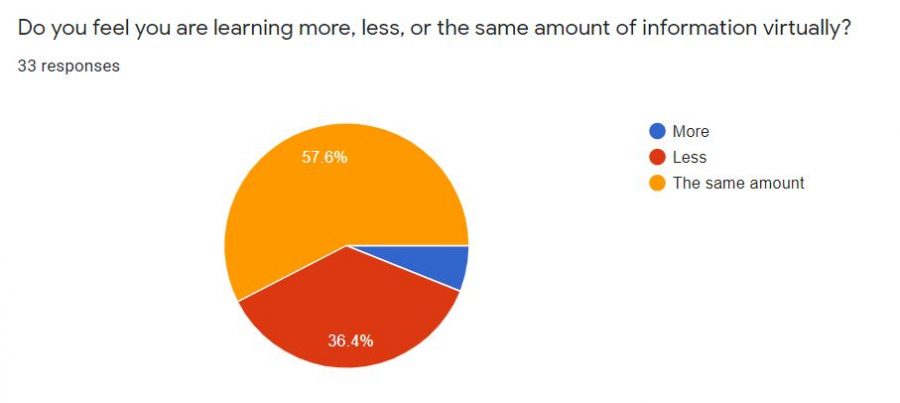Students share benefits and setbacks of virtual learning
Virtual students surveyed in late April had mixed results about just how much they are learning in a recent survey. Thirty-three students who were randomly selected reflected on their virtual experience.
Before April 19, high school and middle school students were divided into three cohorts: A, B, and V. Cohort A students would go to school on Mondays and Tuesdays, Cohort B students would go to school on Thursdays and Fridays, and Cohort V students would stay home all week. Wednesdays were reserved for all students to learn from home.
However, with COVID-19 guidelines becoming more relaxed, Kingsway made the decision to combine cohorts A and B on April 19th in order to give in-person students more opportunity to ease back into regular, non-virtual learning. Virtual students are still learning from home through meetings on Mondays, Tuesdays, Thursdays and Fridays. Wednesdays are still reserved for all cohorts to learn from home without any meetings.
Most Cohort V students have been virtual all year due to health and safety regarding COVID-19, but some switched to being all-virtual on April 19 when the cohorts were collapsed.
The comfort of home, family, and pets truly does help out with the stress that may come from virtual learning. But after a while, it becomes easy to get tired of learning from home, especially with the new collapsed-cohorts system.
A survey was conducted based upon the idea that students may not be learning as much as they would in school. Out of 33 students, about 58% reported learning the same amount of information through virtual learning. About 36% reported learning less. A small percentage of students reported learning more. So, why is it that virtual learning seems to be a setback for some and a benefit for others?
Several students reported in the survey that it can be easy to get distracted during virtual learning when they have their phones, siblings, and electronics on in the background of classes. Since virtual learning can be boring for some students, it is easier to get distracted. If students are not motivated to learn due to boredom and distractions, the schoolwork may seem more difficult; especially from home. One student reported that too many online meetings make school days seem ongoing, especially since there’s not much time away from the computer.
As shown in the chart below, about 42% of students reported getting less attention from teachers during virtual classes. About 56% reported receiving the same amount. A small percentage of students have reported they were getting more attention from teachers.

As the year comes to a close, it can be difficult for teachers to find a happy medium while teaching the at-home students. If there wasn’t so much time on the computer, it could be possible that students wouldn’t learn as much. But hours in front of a screen may also contribute to why some virtual students feel they are not learning.
On the contrary, virtual learning has made many students feel more productive and organized due to the responsibility associated with learning from home. Whether students are still learning or not may vary between different high schoolers, but one thing is for certain: nothing compares to going to school and interacting with peers face-to-face.

